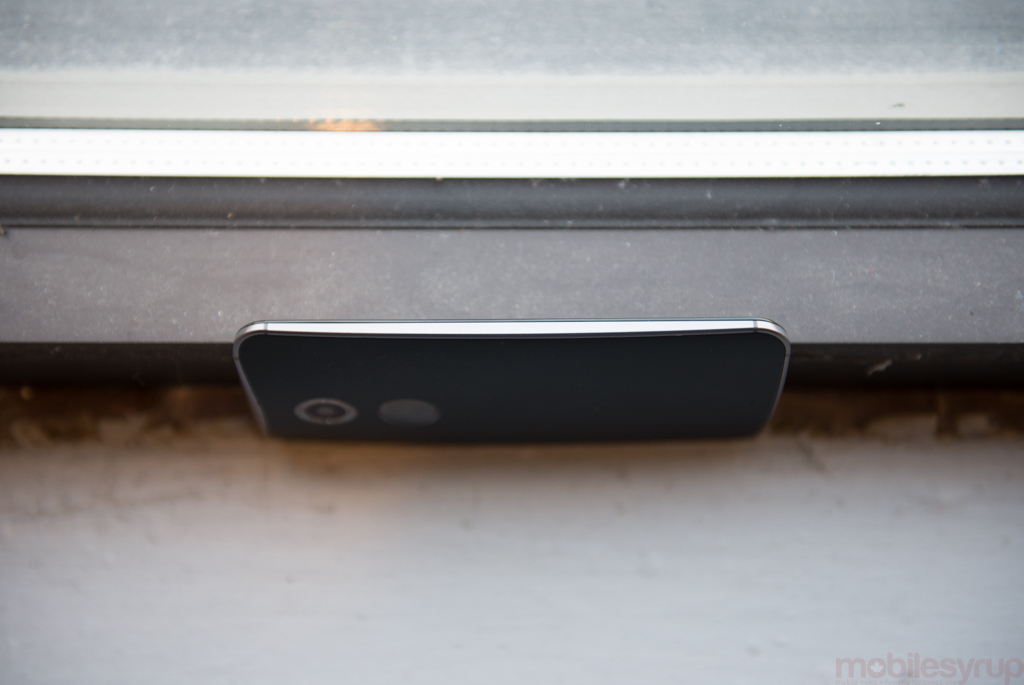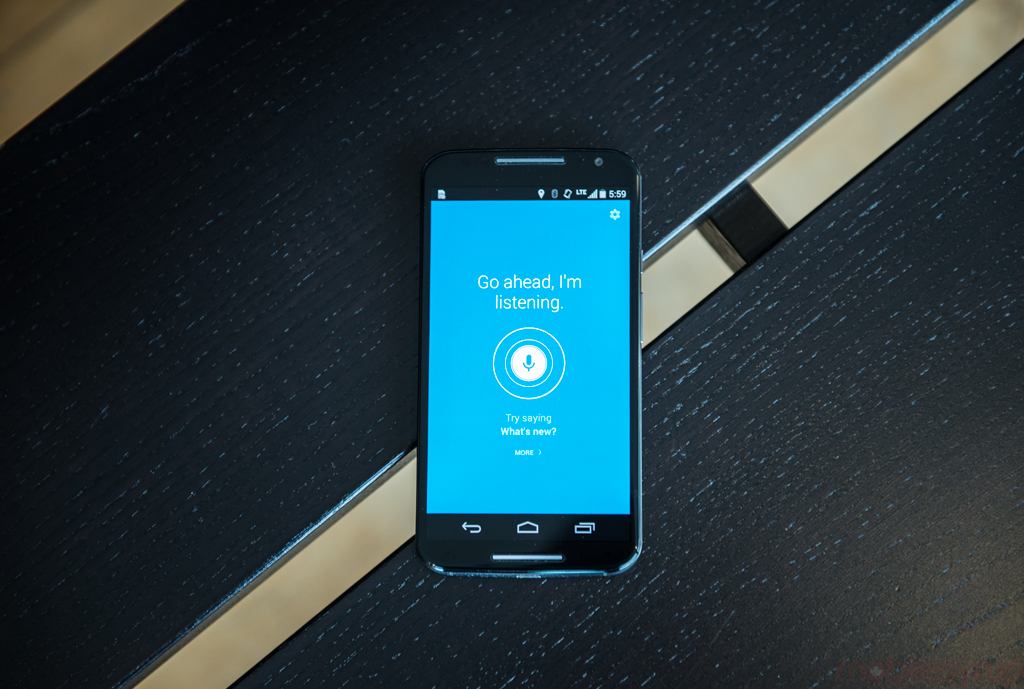
Two years ago, Motorola’s best phone was something called the RAZR HD. Or it could have been the ATRIX HD LTE.
At the time, the company’s focus wavering, it released too many devices in broad strokes that appealed to few. It tried to reinvigorate its legacy by recalling the RAZR name, but the device was buggy and slow, with a poor screen and overbearing software. By the time the RAZR HD came along, competitors like Samsung and LG were offering compelling alternatives with better specs and more capable software. While the seeds of what would eventually become the Moto X were alive somewhere in Motorola’s Chicago headquarters, it wasn’t until the company was subsumed into Google that the new identity we know today was formed.
When then-CEO Dennis Woodside introduced the Moto X to a small group of journalists in early August 2013, I was fascinated by the company’s singular focus. Take stock Android (which, he told us, was better than any skinned version) and build on it, improving the core feature set with a great camera experience, a superlative notification solution and ubiquitous voice access. This was Google’s best, branded as Motorola.
With the new Moto X, Motorola marks its best smartphone ever with a solemn farewell: the company is set to be subsumed into another once again, but this time its devices will be distributed by Chinese giant Lenovo. With Motorola pushing its Moto G into more markets, does the X have room to maneuver in the high-end smartphone space? Let’s find out.
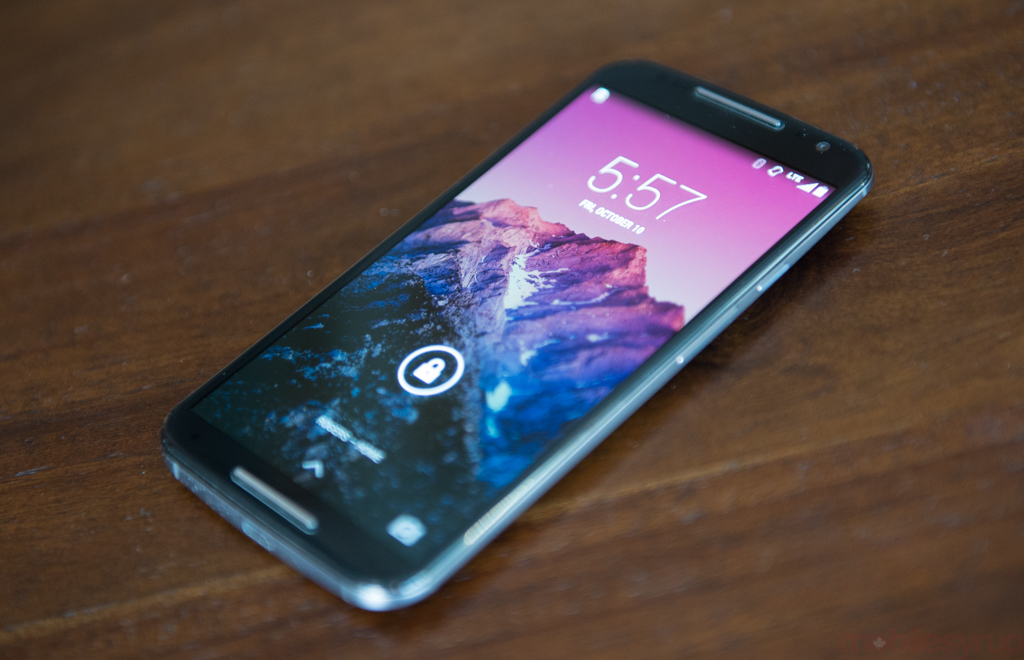
Specs
- Android 4.4.4 KitKat
- 5.2-inch 1920×1080 pixel AMOLED display (423ppi)
- 2.5Ghz quad-core Qualcomm Snapdragon 801 SoC
- 2GB LPDDR3 RAM / 16GB internal storage (no microSD)
- 13MP rear camera / 2MP front camera
- 4K video capture @ 30fps, 1080p @ 30fps, 720p @ 120fps
- WiFi (a/b/g/n/ac), Bluetooth 4.0 LE, A-GPS, GLONASS, NFC
- 2,300mAh battery
- 140.8 x 72.4 x 9.9mm
- 144 grams
- UMTS/HSPA+ (850, 900, 1700 (AWS), 1900, 2100 MHz), 4G LTE (02, 03, 04, 05, 07, 17, 29)
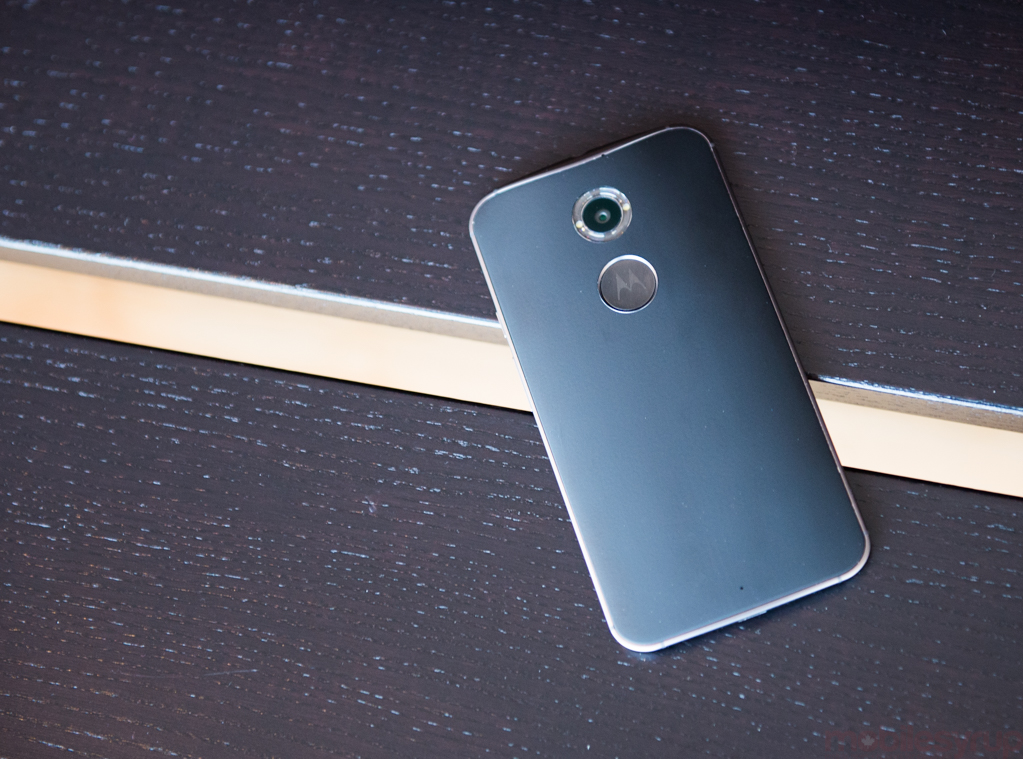
Introduction
The original Moto X was so good because it spared no space: its 4.7-inch display was surrounded by some of the slimmest bezels we’d seen on a smartphone to date. Its rounded back made it comfortable to hold, and the dimpled Motorola logo attracted the index finger to act as balancing agent when maneuvering on the screen with a thumb. It was a wonderful, warm transition from the cold metal of the HTC One and imbalanced plastic of the Samsung Galaxy S4.
Much of that charm has been lost in the transition to the second-generation Moto X, but what is in its place is both mature and capable. The metal frame feels solid — you should see my chewed-up OG Moto X for proof that plastic isn’t always better — and the larger size only took a few days to grow used to. It’s a bigger, faster, more capable Moto X. But is it better? That’s one of the hardest questions I’ve had to answer all year.
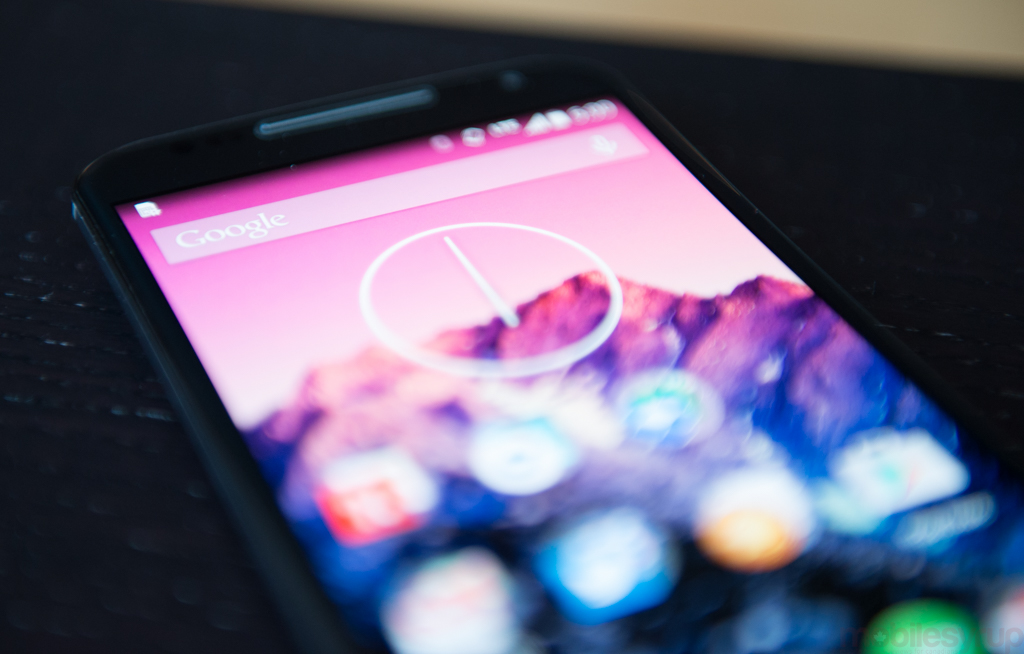
Design & Display
On the surface, the new Moto X is way better than the original. A larger, higher-resolution AMOLED screen; a much-faster processor; an improved camera sensor; a larger battery; better notification and voice control access.
While I never opposed the decision to include a 720p display on the Moto X, there was no question as to whether Motorola needed to up its game on the sequel, especially as newer devices in the 5-inch+ range are now equipped with 1440p panels.
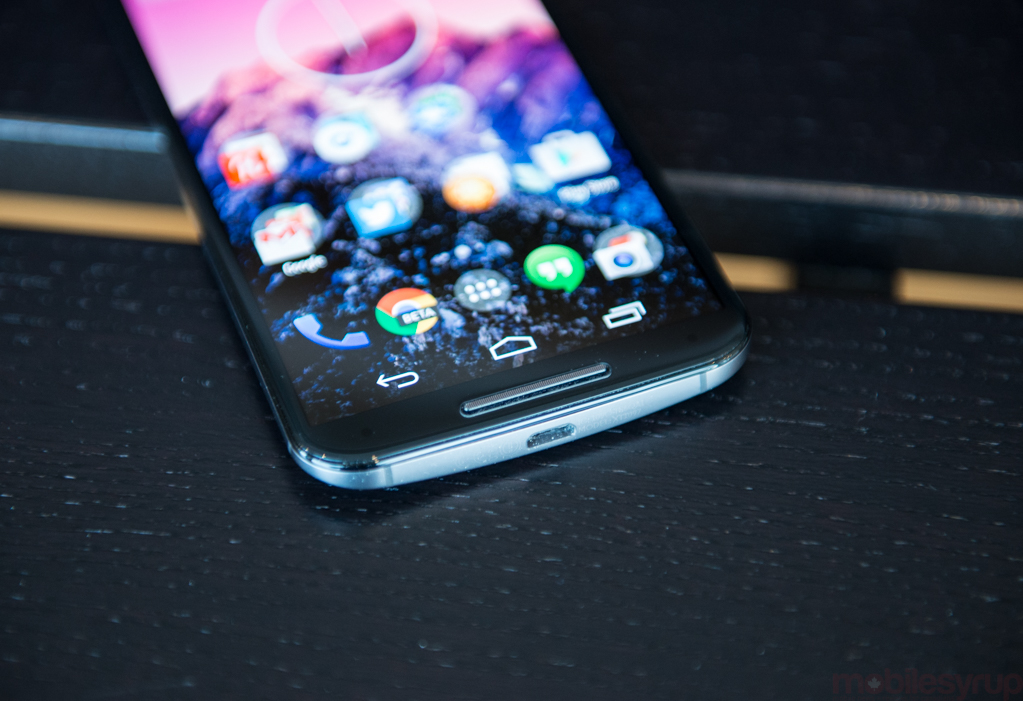
To the uncritical eye, the 1080p device on the Moto X is quite good, but it seems familiar. I’d heard that Motorola was merely recycling panels from the Samsung Galaxy Note 3 / Galaxy S4 era, the first AMOLED displays to feature the lauded diamond subpixel array, and it turns out I was right: the new Moto X has a 5.2-inch panel shares characteristics with the 5-inch GS4 and 5.5-inch Note 2. The same was true of the original Moto X, which used a similar panel to the Note 2, just shrunk to 4.7-inches.
Not only does using last year’s technology lower the costs to Motorola, but it ensures quality is uniformly good, since Samsung has had ample time to fix any manufacturing output issues from its display fabrication. But it also ensures that the Moto X, despite its flagship pedigree, lacks the advancements in AMOLED technology made over the past 12 months. As we saw in the Galaxy S5 and the upcoming Note 4, Samsung has not only increased brightness but widened viewing angles and brought colour saturation under control.

The new Moto X suffers from the same oversaturation as any 2013-era AMOLED panel, which is to say it’s quite hot. White balance is merely OK, redder than last year’s Moto X. It’s a personal preference, and one I enjoy quite a lot, but other than screen density Motorola hasn’t drastically improved the Moto X’s screen.
The main problem with the Moto X’s display is its maximum brightness: it’s just not very good. While AMOLED is known to have poorer brightness than LCDs, Motorola likely limited its maximum to stave off battery demons. For indoor usage, the screen is fine; outdoors is a different story, with the display becoming washed-out and difficult to read.
Adding metal to the frame is another sign of maturity on the Moto X’s part. Not only does the new design encourage a more power antenna system, which means better signal regardless of how the phone is held, but the phone feels a heck of a lot sturdier.
Despite having a 5.2-inch screen, the new Moto X is still significantly smaller than many devices under 5-inches. It may not be thinner than the average flagship, but the curved edges and thin bezels give it an edge. There isn’t much to say about the front, but the back has a new dual-LED ring flash that undermines the simplicity of the rest. It’s not ugly, per se, it just looks out of place on this Moto X.
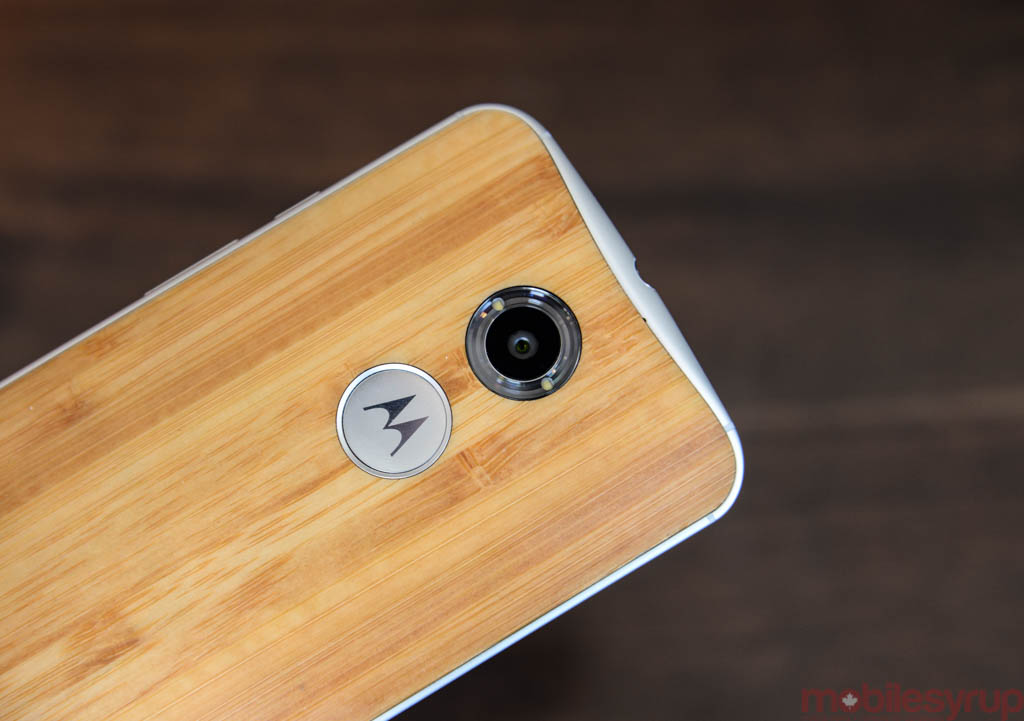
Performance & Battery Life
Frankly, the new Moto X performs as well or better than practically every Android phone out there. While last year’s model arrived dated out of the box — its S4 Pro SoC was over a year old in August 2013 — Motorola wouldn’t make the same mistake twice.
This year, the Moto X comes with a Snapdragon 801, the same chip found in the Samsung Galaxy S5, HTC One M8, Sony Xperia Z2 (and Z3), LG G3 and many others. It’s also paired with 2GB of RAM and excellent IO optimizations (Motorola seems to be the only company optimizing its storage).
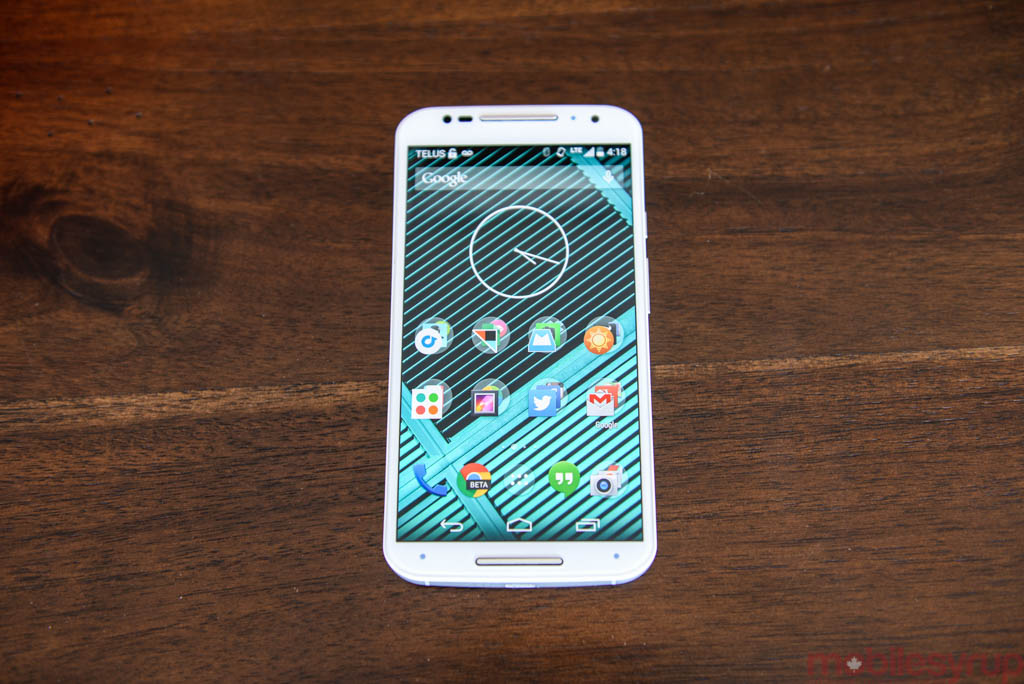
Let’s backtrack a little bit, though: high-end Android smartphones are all about power, each core running above 2Ghz these days. But Android as an operating system does not need that power. As we’ve shown with the myriad Snapdragon 400-based devices released over the past six months (and the fact that the OG Moto X is still capable of doing just about everything), hardware is increasing in power faster than the software can take advantage of it. Sure, you may see a few more frames per second in the latest Modern Combat title, but most people play Candy Crush and 2048.
That being said, Motorola suffused its newest smartphone with the latest and greatest chip not necessarily for the speed improvements found therein but for its added efficiencies, especially in the realm of battery life.
With a scant 2,300mAhs in the tank, the new Moto X trails the One M8, Galaxy S5 and LG G3 in total battery capacity, and the cell needs to work harder than last year’s 2,200mAh-filled Moto X to keep that 1080p screen nice and bright.

So we have a battery that’s 5% larger than last year’s model powering a screen that has four times the number of pixels. As we said, Motorola already dealt with the increased battery draw of a higher-res screen by limiting maximum brightness, but the value of having the latest Qualcomm chipset is all the efficiencies it brings.
As we saw with the LG G2 to the LG G3 (Snapdragon 800 to 801), Qualcomm made some incredible jumps in battery efficiency in its latest generation. The new Moto X takes advantage of many of them, but still falls short in overall uptime due to the relatively small size of the cell.
We achieved between 11 and 13 hours of use on a typical day. Say you take the phone off the charger at 8am, you’re looking at the edges of panic around 7-9pm. While this is not a deal-breaker considering the phone’s virtues in every other area, it’s something to keep in mind. This is the iPhone argument: would you rather a phone that does everything better than the competition last for a nominally shorter period, or a thick, oversized device that offers a qualitatively poorer experience? I’d go for the former every time because, well, it’s not difficult to charge a phone, but it’s very difficult to get hardware and software working together.
But quantitative results don’t hold up nearly as well. The new Moto X lasted 7 hours, 1 minute in our video looping tests, which keeps the phone on WiFi and loops a video clip, with the screen locked to 200nits, until the battery depletes. This is 38 minutes longer than last year’s Moto X, but considerably lower — in some cases, nearly 50% less — than the HTC One M8, LG G3 and Samsung Galaxy S5.
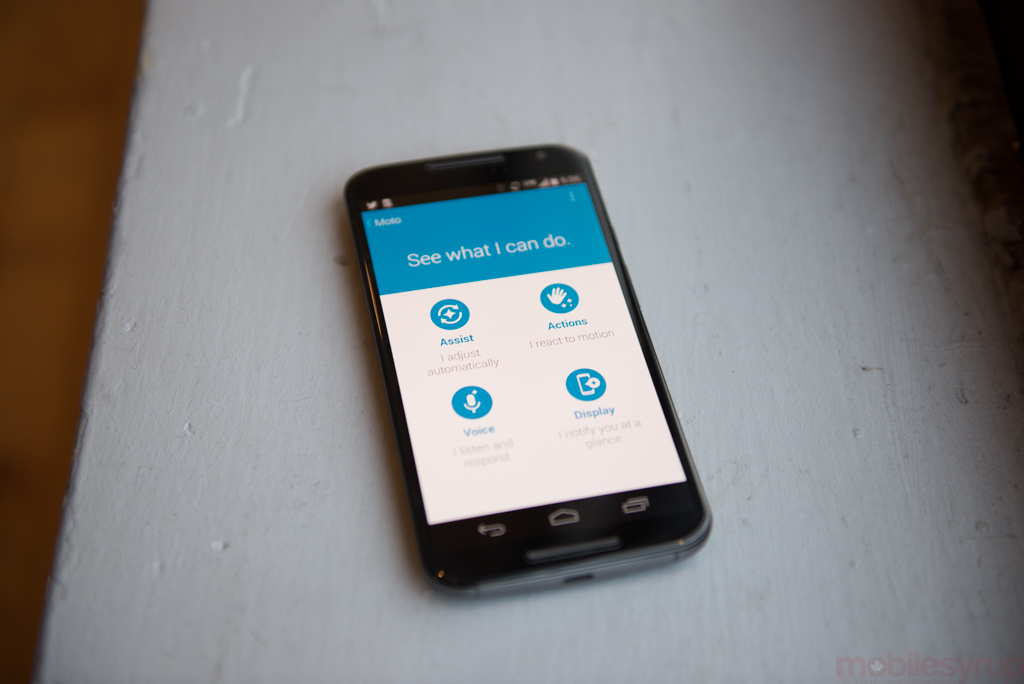
Software
Great Android performance comes from highly optimized software, and the Moto X is about as unsullied an Android experience as it gets.
Unsullied is an interesting adjective to use because it infers that other manufacturers sully Google’s “pristine” Android code with bloat and performance-lowering features. But that’s increasingly not the case: HTC, Samsung, LG — even Huawei and Alcatel OneTouch — are pairing faster chips with more conservative software changes.
But I believe that stock Android is not just a better user experience, but a quantifiably faster one. When we visited the company’s Chicago-based headquarters, employees were on hand to show that the new Moto X and Moto G were actually considerably faster at completing everyday tasks, from loading an app to taking a photo, than flagship devices from Samsung and HTC.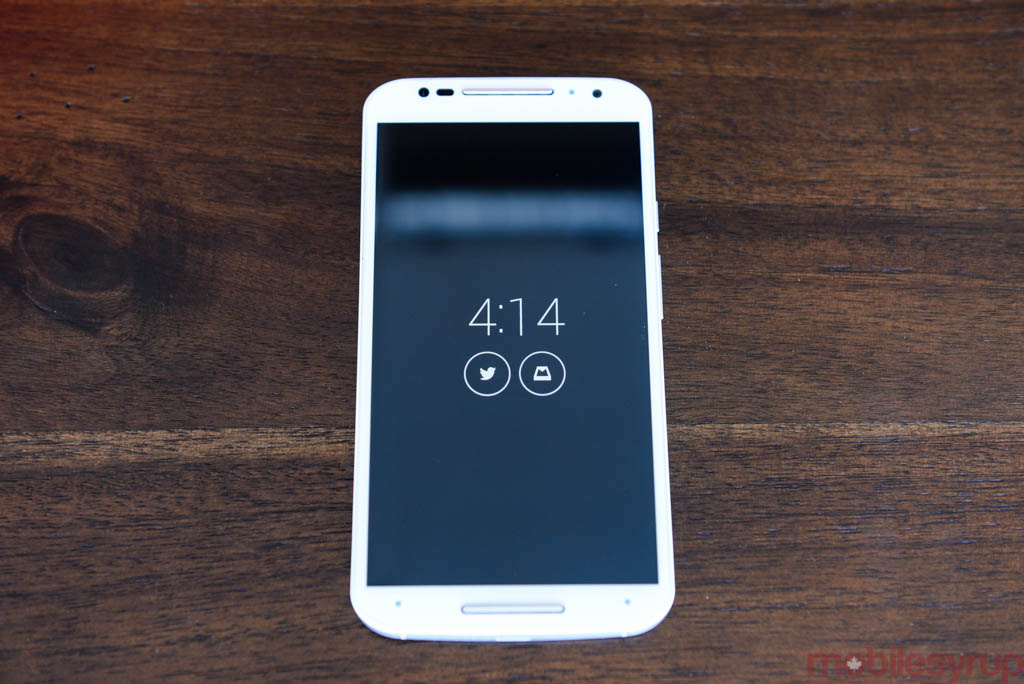
Motorola took the foundation it built last year and improved upon it. Active Notifications are now under the Moto Display umbrella, and up to three notifications are displayed on the lock screen.
Moto Display utilizes four infrared sensors on front of the Moto X to detect movement, even in low-light situations. Swipe your hands over the screen to initiate the AMOLED screen and then tap to see the notifications. It’s so simple and so effective, returning to another device feels like a regression.
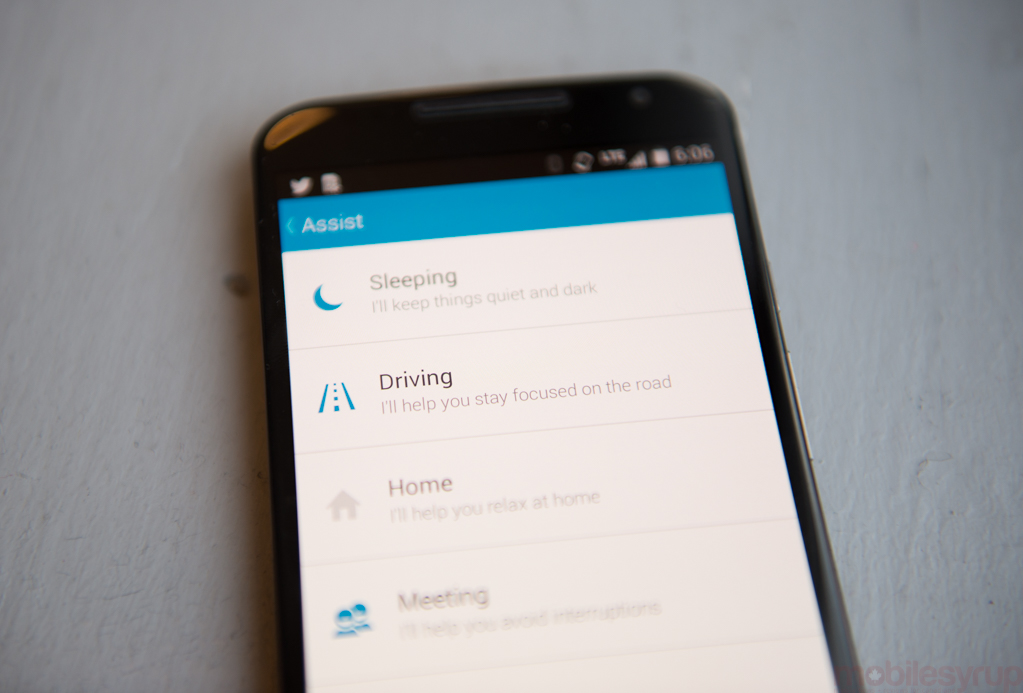
The infrared sensors perform more than one function, though: swipe over an alarm to silence it, or a phone call to mute it. And because the Contextual Services app that powers Moto Display sits in the Play Store, Motorola can add features without releasing a firmware update.
Also improved this year is Touchless Controls, now called Moto Voice (see a simplifying trend?). Instead of saying “OK Google Now,” the voice control action can be set to practically anything, though there are minimum syllable requirements that ensure the device’s multiple microphones can isolate one’s voice from a crowded room.

Though Moto Voice is considerably more useful than last year, it’s still less an essential feature than an under-utilized perk. Asking “What’s New” springs Google Now to life with a run-down of one’s calendar entries and other pertinent information, while asking it to “Take a selfie” or “Send a WhatsApp message” does what you’d expect.
On a technical level, the voice recognition is significantly improved over last year, able to toggle from further away. We experimented on the two devices by changing the action toggle back to “OK Google Now” for the new Moto X (the old one can’t be altered) and standing in increasing distances from both devices. The new model was able to pick up our command more than five feet further.

Other areas of strength for Motorola continue to be around the simplicity of services that other companies unnecessarily complicate. A single Moto app replaces disparate services around the OS, allowing users to control what used to be separate processes for Moto Assist, Actions, Voice and Display.
One of the most useful features of the Moto X is something most people won’t be able to take advantage of: Trusted Bluetooth Devices. Paired with an Android Wear smartwatch or Motorola’s upcoming Hint, or any accessory that supports Bluetooth LE, when it comes within range of the Moto X it releases the lock screen security. Walk far enough away and the security returns. It’s one of those features that not only justifies the addition of a Bluetooth-based peripheral to one’s repertoire but it quickly becomes invaluable.
That Motorola builds these features on top of stock Android 4.4.4 KitKat, and elects to use the Play Store-updatable Google Now Launcher, not only lowers the development overhead but improves the turnaround time for new software versions. And because there is no software bloat (TELUS only installs a single app) there is a significant user advantage.
This is the best software experience I’ve ever had on an Android product, and OEMs need to stand up and take note.

Camera
If there was a major Achilles’ Heel in last year’s Moto X, it was the camera experience. We reviewed the phone shortly after its release and found photo and video results to be, frankly, awful. Things improved after a couple of firmware updates from Motorola — white balance in low-light situations went from bad to merely acceptable — but we were never comfortable relying on the device.
This year, Motorola went with a more traditional sensor, a 13MP Sony IMX135 part that boasts an F2.3 aperture. This is the same sensor found in the LG G2 (and similar to the LG G3 and OnePlus one), and promises a good compromise between spacial detail and low-light performance.
The IMX135 has proven reliable in the past, but devices like the LG G2 compensated for the relatively small pixel size by including optical image stabilization, or in the case of the OnePlus One, a wider aperture that lets in more light.
The new Moto X is blessed with neither of those advantages, so low-light performance is pretty abysmal. In fact, Motorola has limited maximum ISO to 1000 and minimum shutter speed to 1/15 in an attempt to minimize grain and prevent motion blur, respectively. While I understand the reasoning for these decisions, the company has locked these numbers at a firmware level, so even third-party apps with manual controls can’t hit the extremes.
We asked Motorola about this and were told that customers complained about grain and blurriness on last year’s model, so these hard limits were introduced to encourage customers to use the new dual-tone ring flash. The flash, however, is far too bright and too often washes out its subjects.
To achieve better results, we turned to the excellent HDR mode, which kicks in by default in certain lighting situations. The two photos above are taken at the same shutter speed and sensitivity, but the one on the right is the composite of three photos at various exposure levels. As long as the subject isn’t moving, it improves an otherwise-drab scene.
Daylight photographs showed a lot of promise, though, and we were generally happy with the optics. The lens has an equivalent 31mm field of view, so it’s not quite as wide as last year’s Moto X, and macro photography is better as a result. The sensor still has trouble capturing minor details, like text on a far-away sign, due to an abundance of processing that is meant to smooth out grain, but for the most part the experience was positive.
Motorola has done a few things to improve the photo-taking experience this year. Thanks to the faster Snapdragon 801 chip and accompanying ISP improvements, the excellent camera app starts up more quickly, and shots are instant. And because of that extra processing power and faster memory, the phone now caches what’s shown in the viewfinder for a few seconds before and after the shutter is pressed.
Using an algorithm to determine facial features (and a number of other metrics), the Moto X offers alternatives to poor photos in real time. Most of the examples the company showed was of a person blinking and the software providing an alternative where they weren’t, but the feature works in a number of other situations.
But through my weeks of taking photos with the Moto X, that feature never kicked in for me. Either I take great photos every time (doubtful) or the algorithm is pretty conservative (more likely). Either way, it’s nice not to have to explicitly enable it like you do on the Sony Xperia line and BlackBerry 10 devices.

The camera interface is still ultra-simple, employing a hold-to-focus and tap-to-shoot workflow. Swiping from the left reveals the few options available, including HDR Mode, panorama, flash toggle and resolution. By default, the viewfinder is filled, but those shots are only 9.7MP photos taken at 16:9; the sensor is 4:3 natively, so I’d recommend changing over as soon as possible.
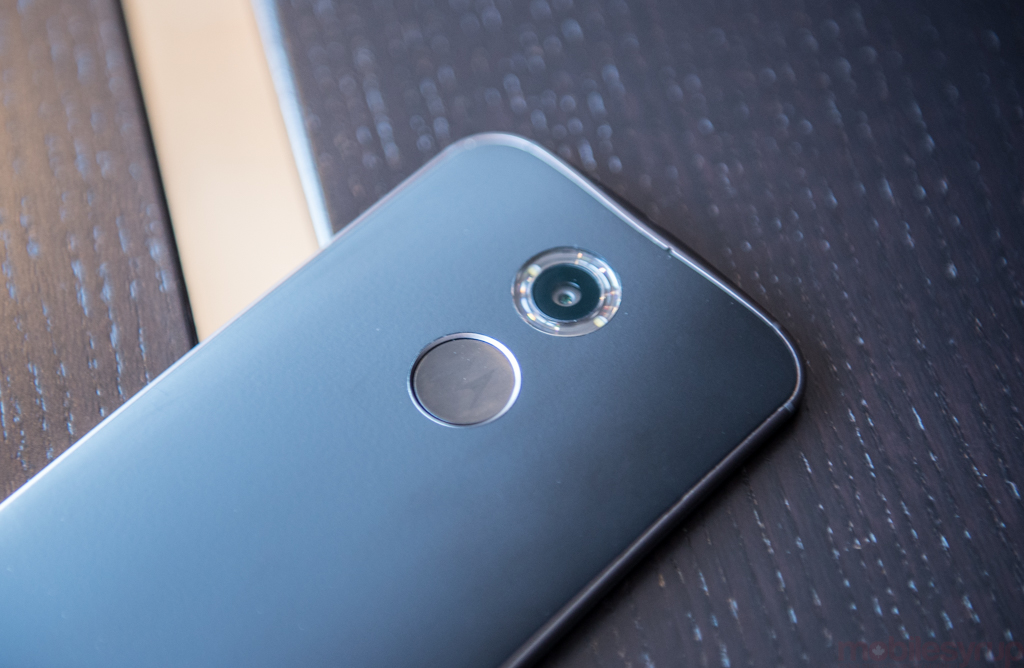
Taking photos on the Moto X is easy, but it’s often too easy: there are no granular controls at all, no way to alter white balance or shutter speed or even ISO. Indeed, focus and exposure, which are unfortunately tied together, are the only manipulable options. That’s the way Apple has gone for many years, but Motorola is going against the grain here. The difference is that, generally, on an iPhone you’ll get a great photo by tapping on the area you want to focus and pressing the shutter button; on the new Moto X, some manual controls may go a long way to improving output. The company says that things will improve with the release of Android L and its updated Camera API 2.0, but that’s a long away for this photography nut.
On the video front, the phone takes 4K video at 30fps and 1080p video at 30fps. It also does 1080p video at 120fps, slowed down to 15fps for a pleasing transition effect. It works quite well, though the processing is not quite as seamless as Apple’s or Samsung’s implementation, both of which are top-notch.
Like with photos, Motorola seems to better at adapting to various lighting conditions, and we were happy with the video results. Unfortunately, the sensor seems to be sensitive to movement, so while capture detail is plentiful, it pales next to products with OIS like the iPhone 6 Plus, Galaxy Note 4 and LG G3.
Connectivity
While Motorola offers a 32GB version of the Moto X via Moto Maker, that variant is not available to Canadians, who, through TELUS, are stuck with a single 16GB model and no expandable memory. Obviously cost is an issue, but the Moto X should come with more than 12GB of free space out of the box. I said it last year and will reiterate it again in 2014.
Like last year’s device, the 2014 Moto X has an excellent headpiece that facilitates wonderfully rich and full phone calls. I wish I could say the same for the single front-facing speaker, which is not only thin-sounding but soft, too. It’s strange to see this year’s Moto G arrive with stereo speakers, and the company’s flagship, which costs twice as much, lacks them.
The Moto X is one of the first device’s we’ve seen to support Qualcomm’s Quick Charge 2.0, and while the in-box charger doesn’t support the standard, Motorola plans to sell a $35 add-on that adds up to eight hours of battery in 15 minutes. In my testing with the charger, the device went from 40% to 95% in an hour, which is pretty darn impressive, especially since battery life is not the Moto X’s forté.
As for network speeds, the Moto X supports 802.11ac WiFi for speeds up to 433Mbps down, and Category 4 LTE up to 150Mbps, though TELUS’s network doesn’t support the bands necessary to take advantage of those speeds. We saw speeds averaging between 15 and 20Mbps down on the TELUS LTE network in downtown Toronto.
Conclusion
The Moto X may not have the best camera, nor the ideal battery size, of the latest generation of Android devices, but it finds its advantages in usability and sheer performance. It feels fast because it is unencumbered with extra layers of code, and more useful because Motorola adds features that people will actually use, not try once and toss aside forever.
I’d say it is the best Android device on the market today, though it comes down to what you prioritize. The LG G3 may have a longer-lasting battery, and the Galaxy S5 a superior screen, but neither provides the ideal combination of hardware and software that Motorola has managed to achieve.
The Moto X is also modestly cheaper than its major competitors: TELUS sells the phone for $100 on a 2-year contract and $600 outright, and it can be had for much less directly from Motorola’s US website with a valid US address.
There isn’t much of a narrative arc here: the Moto X isn’t a dramatic smartphone. It’s a great smartphone at a good price, with excellent software support and the promise of quick OS updates down the road.
MobileSyrup may earn a commission from purchases made via our links, which helps fund the journalism we provide free on our website. These links do not influence our editorial content. Support us here.


